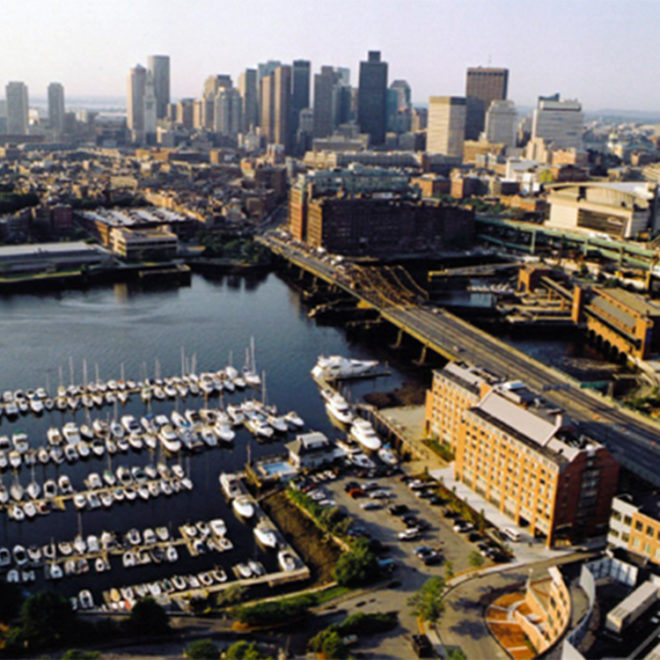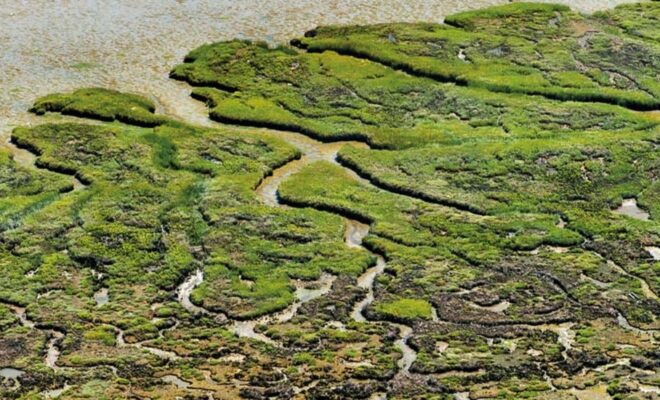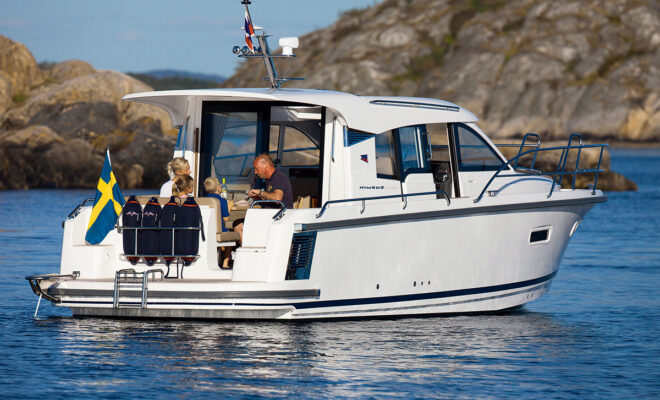Boating, Fishing, and Travel Information for Boston, MA
For the first-time cruising visitor, Boston Harbor and approaches might seem intimidating. This is one of America’s busiest ports with ships, tugs, barges, commercial fishing boats plying the waters at all times. But if you stick to the channels it’s a fairly easy and boater-friendly place to navigate. And the city offers world-class cuisine, iconic sites for the history buff (sail by the USS Constitution, for instance), theater, shops, and museums, and much more, all within reach of your anchorage.
Things To Do for Boston, MA
There’s plenty to do in Boston without traveling far from the waterfront:
The New England Aquarium – You don’t have to be a kid to enjoy this Boston staple. From sharks to jellyfish, penguins to octopus, and everything in-between, the aquarium is an experience that never gets old.
ICA Boston – Boston’s most renowned contemporary art museum is located right on Boston Harbor, with great views of the waterfront that fit seamlessly with the impressive and always-changing collections of art.
History Buff? – Boston was practically made for you. The USS Constitution is the world’s oldest commissioned war chip afloat, and it’s docked at the Charlestown Navy Yard. The Boston Tea Party Ship & Museum was voted #1 “Best Patriotic Attraction” by USA Today. The Freedom Trail offers guided (and costumed!) walking tours featuring 16 of Boston’s most nationally significant historic sites.
The Rose Kennedy Greenway – If you weren’t expecting to find nature in the heart of Boston, The Greenway will be a welcome surprise. The Greenway Conservancy uses organic and sustainable practices to maintain the park’s trees, plantings, and lawns to provide a welcoming natural sanctuary in the midst of the bustling city. In addition there are food trucks, a carousel, a wine garden, art exhibitions, and more! Check the events calendar and you’ll find a wide variety of offerings that take place in this beautiful setting.
Visit the Boston Harbor Islands – There are 34 islands and peninsulas in the Boston Harbor Islands National and State Park just waiting to be explored. Ferries run from mid-May through mid-October.
Hop On A Bike – Got places to go? Metro Boston’s public bike share program Bluebikes is an affordable and convenient way to zip around the city. You can become a member online, or buy a pass from any Bluebikes station kiosk or through the mobile app. Then, just hop on, take a ride, and return the bike at any of the 260 stations across Boston, Brookline, Cambridge and Somerville. If a bike share isn’t quite what you’re looking for, Urban AdvenTours offers a number of private and group bike tours of the city.
Boston Duck Tours – Want to see Boston, but can’t decide if you want to see it from the land or from the water? Look no further than Boston Duck Tours! The city’s famous aquatic vehicles offer a number of guided tours of all the major can’t-miss landmarks.
Helpful Resources for Boston, MA
Local Goods & Services See All Nearby
Boating in Boston, MA Map View
Repairs
The port of Boston has excellent facilities for making all types of hull and engine repairs to vessels of all sizes. Several of these firms operate waterfront facilities for the vessels of all sizes. In addition, there are a number of firms without waterfront facilities that are engaged in marine repair work. These companies maintain shops and portable equipment for making repairs on all types of craft at their berths.
Small-craft Facilities
Public float landings for small craft are at Summer Street, Northern Avenue, on Charles River, and several other places along the waterfront. Small-craft facilities at Boston and Charlestown can provide berths with electricity, water, ice, marine supplies, wet storage, and sewage pump-out; complete hull, engine, and electronic repairs are available.
The Jeffries Yacht Club is in the cove adjacent westward of Logan International Airport. A boatyard, close southwestward of the yacht club, has a marine railway that can handle vessels up to 100 tons for hull and engine repairs; a 10-ton crane is also available.
Tides: Mean tidal range is 9.5 feet.
Boston Harbor branches into several distinguishable areas. Chelsea is separated from Charlestown, on the western side of the harbor, by the Mystic River. Charlestown is separated from Boston proper by the Charles River. Charleston Navy Yard is located on the north side of the mouth of the Charles River and is home to the USS Constitution and USS Cassin Young.
South Boston is on the peninsula southeast of the city proper, from which it is separated by Fort Point Channel. Logan International Airport is between Governors Island Flats and East Boston. The airport area, almost entirely filled land, is low, flat and quite extensive. The airport control tower is conspicuous. Governors Island, on the northeast side of Boston Main Channel and at the southerly end of the airport, is a low grass-covered peninsula.
Castle Island, on the southwest side of Boston Main Channel 1 mile northwestward of Spectacle Island, is marked by Fort Independence. It is connected to the shore westward by filled land. Several boulders bare at low water are a short distance southeastward of Castle Island. This area should be avoided. On the northeast corner of the island is the 52-foot granite Donald McKay Monument, erected in 1933 to commemorate the famous East Boston builder of clipper ships.
Pleasure Bay, just westward of Castle Island, is closed by an earth-filled dam extending from the southern end of the island to the jetty light southeastward of City Point.
Reserved Channel, 0.5 mile northwestward of Castle Island, is a dredged unmarked channel that leads westward from the Boston Main Channel for about 1 mile. The channel has a depth of 40 feet to about 0.5 mile above the entrance, thence 28 feet to the head of the project. A fixed bridge near the head of the dredged channel has reported clearances of 40 feet (horizontal) and 6 feet (vertical).
Fort Point Channel separates Boston proper from South Boston. A dredged channel leads from the entrance to the Summer Street Bridge. The controlling depth is 11 feet to the Northern Avenue Bridge and 14-15 feet to the Summer Street Bridge. Using the chart, Fort Point Channel is navigable to just below Dorchester Avenue Bridge.
The navigable section of Fort Point Channel is crossed by four bridges. Northern Avenue Bridge, at the entrance, has a swing span with a clearance of 7 feet. Moakley bridge, a highway bridge just above the Northern Avenue bridge, has a fixed span with a clearance of 16 feet. The Congress Street Bridge has a fixed span with a clearance of 6 feet, and the Summer Street Bridge has a fixed span with a clearance of 8 feet.
Charles River, on the western side of the harbor between Boston proper and Charlestown, is the approach by water to Cambridge and Watertown. The entrance of the river to the Charlestown Bridge, the first bridge, has a controlling depth of 26 feet. A wreck, covered 29 feet, is near the middle of the entrance and an obstruction, covered 13 feet, is near the southern limit of the channel, 240 yards east of the bridge.
Charles River Dam is about 0.55 mile above the entrance to the river. The dam has three locks; the large north lock has a usable length of 300 feet and width of 40 feet with 14 feet over the sill; the other two locks have usable lengths of 200 feet with widths of 25 feet and 6 feet over the sills. An overhead walkway with a monorail beneath it across the downstream end of the locks has a least clearance of 26 feet. A second dam is about 1 mile above the entrance with a single lock that’s maintained in the open position. The controlling depth between the two dams is 15 feet.
Charles River above the dams is maintained at a height of 7.2 feet above mean low water. There is a average depth of 15 feet to Arsenal Street Bridge, thence 3 feet for 2 miles to the head of navigation at Galen Street Bridge in Watertown.
The river above the dams is used by many yachts and small craft. No toll is charged for passage through the locks. There are four yacht clubs on the river, some college sailing and rowing clubs, a large marina below the dams and two public float landings above the dams.
The Charlestown Bridge crosses the river just below the lower Charles River Dam and has a fixed span with a clearance of 23 feet. Use the south span. The Interstate 93 highway bridge about 100 yards upstream of the lower dam has a fixed span with a clearance of 48 feet due to an overhead pipeline being suspended from below the bridge.
Little Mystic Channel is a slip about 0.5 mile long 0.2 mile south-southeast of the mouth of the Mystic River at Charlestown. Midchannel depths above the 35-foot dredged berth range from 29 feet just east of the highway bridge to 17 feet 600 yards westward of the bridge. The fixed highway bridge over the channel has a clearance of 9 feet. The horizontal clearance in the channel is limited to 75 feet due to the remains of the approaches of the former Chelsea Street Bridge immediately downstream.
Chelsea River, locally known as Chelsea Creek, emptying into Boston Harbor from eastward between East Boston and Chelsea, is the approach to important wharves and facilities, and to the city of Revere at the head, 2.6 miles above the entrance. The average minimum mid-channel depth is 31 feet.
Two drawbridges cross the river. The Andrew P. McArdle Bridge, just above the mouth, has a bascule span with a clearance of 20 feet, and the Chelsea Street Bridge, 0.8 mile upstream, has a bascule span with a clearance of 9 feet. In the open position, the bascule span of the Chelsea Street Bridge overhangs the channel above a height of 83 feet. The bridgetender of these bridges monitor VHF-FM channel 16 and work on channel 13.
Chelsea River has a heavy traffic of deep-draft oil tankers. The tankers berth at the oil company terminals and storage areas on both banks of the river.
Mystic River, which empties into Boston Harbor opposite Chelsea River, is the approach by water to the towns of Medford and Malden.
The Massachusetts Bay Transportation Authority (MBTA) railroad bridge, just upstream from the Malden River entrance, has a fixed span with a vertical clearance of 30 feet above normal pool level. The Wellington Bridge, 2.2 miles above the mouth, has a bascule span with a clearance of 16 feet at normal pool level. The Harvard Street Bridge (General Lawrence Bridge), 3.3 miles above the mouth, has a bascule span with a clearance of 13 feet at normal pool level. The Wellington and Harvard Street Bridges are maintained in the closed position. Highway 93 bridge about 0.5 mile above the General Lawrence Bridge has a fixed span with a clearance of 16 feet at normal pool level. Note: Normal pool level is 6.2 feet above mean low water.
A large marina is on the north bank of the river, just westward of the Boston and Maine Railroad bridge. Gasoline, water, ice, marine supplies, storage facilities, a small-craft launching ramp, and a 15-ton mobile hoist are available; hull, engine, and electronic repairs can be made.
There are two yacht clubs on the river above the mouth of the Malden River: the Winter Hill at Somerville and the Riverside at Medford. The Chelsea Yacht Club is on the north bank on the east side of the Mystic River-Tobin Memorial Bridge. Gasoline, diesel fuel, water, and electricity are available at the floats, which have 30 feet alongside.
Navigation:
NOAA charts 13272 (1:10,000), 13270 (1:25,000) and 13267 (1:80,000). CharKit Region 2, pages 49 and 50
Boston Harbor, the largest seaport in New England, includes all the tidewater lying within a line from the southern extremity of Deer Island to Point Allerton, about 4 miles to the southeastward.
Prominent Features:
- Boston Lighted Whistle Buoy B (42¬∞22’42″N., 70¬∞46’58″W.) is about 7.8 miles east northeastward of Deer Island. The buoy is equipped with a fog signal and racon.
- Conspicuous to a vessel approaching Boston Harbor from northeastward is the tall red, white, and blue standpipe on Winthrop Head.
- From eastward, the most prominent island in the entrance is Great Brewster.
- On the south side of the entrance, a turreted tower is conspicuous on Point Allerton; also prominent are the tank and standpipe on Strawberry Hill. Two miles south of Point Allerton are two radio towers that are illuminated at night.
- The outstanding landmarks in the city of Boston are the John Hancock Building, the Prudential Building, the bridge over Mystic River, the control tower at Logan International Airport, the pointed tower of the customhouse, and a large gas tank in Everett. Also prominent are the John F. Kennedy Federal Building in Boston and a spire at Squantum.
Approaches:
Although there are numerous hazards adjacent to the approaches to the harbor, the approaches are marked by a number of powerful lights, and the principal dangers are buoyed. The northeastern approach is obstructed by islands and shoals that extend 4 miles from the entrance; between them are the dredged channels which lead into the harbor. In the southeastern approach, broken ground extends as much as 3 miles from shore.
- For those unfamiliar with the area it’s recommend you enter either the Boston North Channel or the South Channel to Presidents Roads, which leads to the entrance to Boston Harbor. Stick to the channels to avoid the numerous hazards outside the buoys.
- At night use the North Channel, which has lighted buoys. If you’re headed for Boston Harbor proceed via Presidents Roads, be watchful for other vessels, as this is a busy area.
- Boston Main Channel extends along the southern side of President Roads to the mouths of the Chelsea and Mystic Rivers, and to Charlestown Bridge on the Charles River.
- There is 40-foot channel from President Roads to the mouth of the Mystic River.
- The right half of the channel from President Roads to Commonwealth Pier 5, South Boston, and the left half of the channel just northwest of Commonwealth Pier 5 to the Charles River has a depth of 35 feet.
- The waters adjacent to the piers and wharves extending northeastward northward from Northern Avenue Bridge to and including Pier 4 along the Boston proper waterfront westward of the Boston Main Channel are non-navigable because of the redevelopment of this section of the waterfront. Uncharted hazards or dangers may exist in these waters. Strangers are advised to seek local knowledge before entering, and all mariners are advised to exercise caution in the area.
High Tide Flooding Predictions for May 2024
By US Harbors. Coastal Flooding Outlook for May 2024 Per NOAA, mean sea level is typically higher in the late spring due to changing weather patterns and increasing water temperatures. That said, the outlook for tidal flooding this May is pretty contained, and is certainly less than we saw a… Learn More
Fishing in Boston, MA Map View
Coastal News Updates See All
Gigantic Marine Reptile's Fossils Found by British Girl and Father
4/26/2024
By Will Dunham. April 17 (Reuters) – A fossil jawbone found by a British girl and her father on a beach in Somerset, England belongs to a gigantic marine reptile dating to 202 million years ago that appears to have been among the largest animals ever on Earth. Researchers said on Wednesday the… SEE MORE
Making a Marsh out of a Mud Pile
4/25/2024
By Erica Gies. In San Francisco Bay, scientists are looking for a better way to rebuild flagging marshland. The water in California’s San Francisco Bay could rise more than two meters by the year 2100. For the region’s tidal marshes and their inhabitants, such as the endangered Ridgway’s rail and the salt marsh… SEE MORE
A New Electric-Powered-Boat Speed Record
4/24/2024
By Kevin Falvey. Princeton Electric Speedboating, in coordination with Flux Marine, achieved a record speed for an electric-powered boat. On October 26, 2023, a team of engineering students at Princeton University—Princeton Electric Speedboating—set a new world record of 114.20 mph for an electric-powered boat. The famed pro-outboard hydroplane Big Bird ran on… SEE MORE





